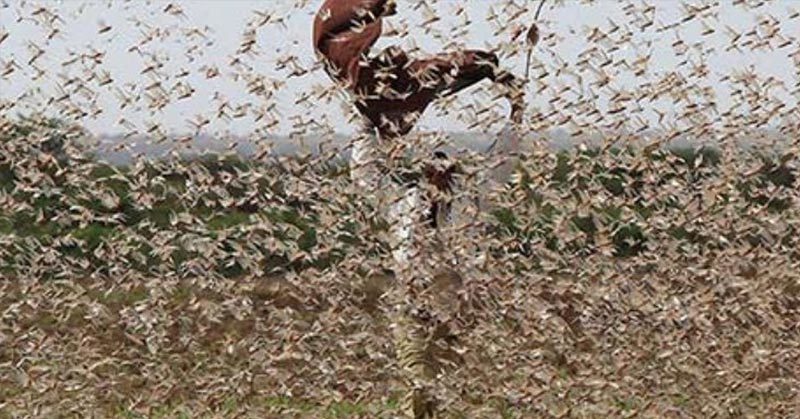The first half of 2020 has been a challenging one, and for many countries, it’s only getting started. On top of the coronavirus pandemic, East Africa is now dealing with a massive locust plague that is threatening the economies of those countries along with the health and livelihoods of the people who live there. If the Australia wildfires weren’t a strong enough sign that we are facing a global climate crisis, then this certainly is.
The East Africa Locust Plague 2020
Weather patterns across the globe are changing rapidly, and this is being felt heavily in many parts of Africa. In 2019, the eastern part of the continent saw one of the wettest years ever recorded, which provided the perfect breeding ground for locusts. (1)
They are now swarming in the trillions, destroying crops from Kenya to Ethiopia and Yemen, even reaching all the way to Northern India. These massive swarms are wreaking havoc on local economies and many in the region are concerned about famine and economic downturn as a result. What’s more concerning, is why this is happening in the first place. (1)
According to Dino Martins, an entomologist that works at the Mpala research center in Northern Kenya, there are four reasons why these ideal breeding conditions are forming (1):
- Local environmental degradation
- Overgrazing
- Deforestation
- Expansion of deserts
Essentially, human intervention that is causing climate change.
“There is a deeper message,” he told the Harvard Gazette, “and the message is that we are changing the environment.” (1)
As climate change continues and weather patterns change around the world, more and more rain will occur in this region, and the locusts will continue to thrive and reproduce.
The first of these incredible swarms, which numbered in the hundreds of billions, appeared late last year due to the unusually warm, wet conditions. This past April, a second wave emerged in the trillions. A third-generation is expected this month, July 2020, that will outnumber that still. (1)
Read: A small city is devoting 1,000 acres of land to America’s vanishing bees
What is a Locust Plague?
Locusts, which look like regular grasshoppers, sometimes live a more solitary life. During dry spells, however, they are forced into the small areas of land that still have vegetation left for them to feed on and live in. They are suddenly crowded together, which releases serotonin in their central nervous systems. This serotonin surge does a couple of things (2):
- Makes the locusts more sociable
- Promotes a more varied appetite
- Promotes more rapid movements
When rain then returns to the region and allows vegetation to return, the locusts, who are crowded together, then reproduce more rapidly. Due to reproduction, they are now even more crowded than they were before, shifting from a solitary life to what’s called a gregarious phase, or a group lifestyle. (2)
The gregarious lifestyle produces a few changes to the locusts (2):
- Their color and body shape
- Increases endurance
- Allows their brains to grow larger
They then create swarms that are typically always in motion, covering up to 80 miles or even more in a single day. They can stay in the air for long periods of time without needing rest, allowing them to cross vast seas and other bodies of water. (2)
Read: 1.5 million cicadas expected to emerge after 17 years underground
Locust Plagues
They are called plagues because they completely devastate agricultural areas, leading to famine and poverty. These have been occurring in parts of Africa and the Middle East since the beginning of time, only now they are getting worse. (2)
Each locust will eat its weight in crops in a single day. While you may not think that sounds like much when you have a swarm of say 40 to 80 million locusts (which can be 460 square miles in size) can eat 423 million pounds of plants in one day. (2)
According to the National Geographic, that’s the equivalent of a swarm the size of Paris eating the same amount of food in a day as half of the population of France. (2)
Read: World record lightning ‘megaflash’ in South America — 440 miles long — confirmed by scientists
Plague Prevention
Currently, the number one solution for controlling locust plagues is by spraying the affected areas with pesticides. As best they can, experts try to compare current weather patterns with historic records to pick out areas where swarms may develop and spray those before they happen. The remoteness of the breadth of the area makes this difficult, however, as do the limited resources that many of these countries have at their disposal. (1, 2)
Rick Overson of Arizona State University’s Global Locust Initiative said recently in an interview with NPR that these solutions are not enough. Not only is their scope too small, but eventually we won’t be able to continue using them. Pesticides, of course, are damaging both to human health and to the environment. (1)
Pesticides do not just kill locusts, but also other important insect species such as bees. These chemicals also eventually sink into the soil, end up leaching into crops and bodies of water, and work their way up the food chain to us. (1, 2)
“The drama and spectacle of the outbreak right now is important to cover, but the more nuanced narrative involves the slow, ratchet method of building infrastructure: If you wait until it’s reactive and forget about it until it happens again, we’re going to be in this situation forever.” he explained. (1)
Locust swarms are a major threat to food security around the world. Action against climate change needs to happen quickly to prevent future devastation from occurring.
Keep Reading: ‘This Scares Me,’ Arctic Hits 100.4°F—Hottest Temperature on Record

